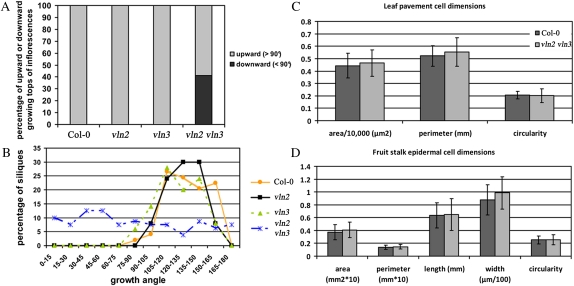Figure 3.
Quantification of the vln2 vln3 phenotype. A, A total of 41% (n = 17) of the tops of inflorescence meristems of vln2 vln3 grow downward, while this never occurs in Col-0 (n = 22) and single mutant (n = 19 for vln2 and 17 for vln3) plants. B, The angle of siliques with respect to the plant axis of the vln2 vln3 double mutant is less regular than that of Col-0 and single mutant plants: siliques of vln2 vln3 grow in all directions at similar frequencies, while those of Col-0 and single mutant plants preferentially grow upward at an oblique angle. C and D, Leaf pavement (C; n = 26 for Col-0 and 61 for vln2 vln3) and fruit stalk epidermal (D; n = 68 for azygous and 67 for vln2 vln3) cell dimensions of vln2 vln3 are similar (Student’s t test, P > 0.05) to those of Col-0 plants, except for fruit stalk epidermal cell width, which is significantly higher (Student’s t test, P = 0.01) to that in vln2 vln3. Circularity reflects the ratio of cell area to cell perimeter and is defined as 4π area/perimeter2 (Vidali et al., 2007). Error bars in C and D represent sd. [See online article for color version of this figure.]

